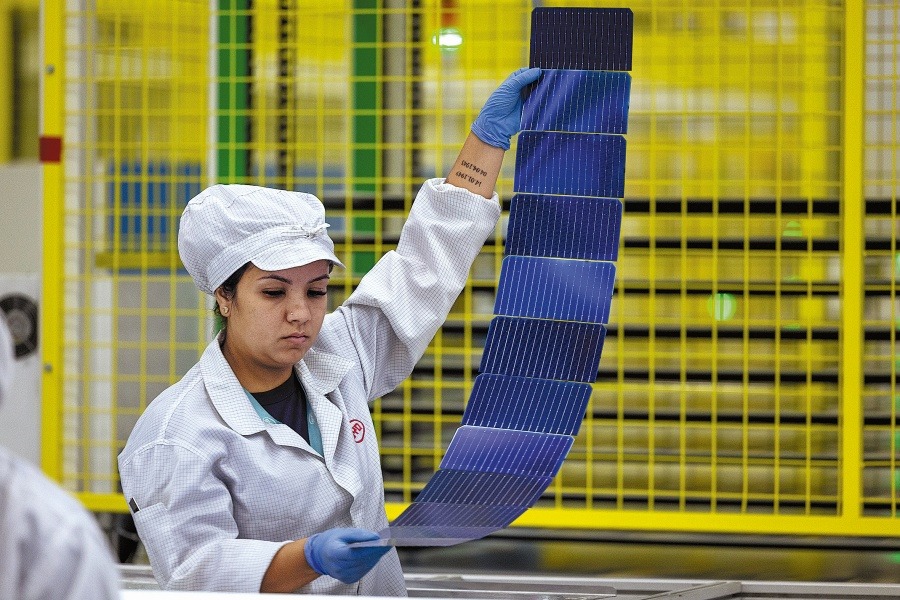Rehabilitation robots awaiting large-scale use


SONG CHEN/CHINA DAILY
Thanks to the rapid development of technology, robotic devices are transforming healthcare, showing promise especially in rehabilitation. Robotic rehabilitation devices offer targeted, repetitive movement therapy, helping patients to recover from stroke, injuries or surgery. However, despite remarkable innovations, widespread adoption of robotics in healthcare remains elusive. To bring these tools from laboratories to mainstream healthcare, increased research funding and strategic policy shifts are essential.
Robotic rehabilitation devices vary in design and function, from exoskeletons for limb support to smaller end-effectors aiding wrist and finger movements. These devices offer personalized, high-precision exercises, allowing patients to perform repetitive, controlled motions crucial for recovery. They also give real-time feedback, track progress and, unlike human therapists, never tire. For patients recovering from conditions such as a stroke or spinal cord injuries, robotic devices have the potential to accelerate their rehabilitation process and reduce dependency on healthcare workers.
In China and other parts of Asia, universities such as Tsinghua University and Beijing Institute of Technology are exploring advanced robotic systems to serve specific rehabilitation needs. Yet these promising technologies are largely confined to research centers, with access limited to elite healthcare facilities.
The question is: What will it take to see robotic rehabilitation on a larger scale, making it accessible for ordinary patients? And what is holding back large-scale adoption?
Despite their potential, robotic rehabilitation devices face significant barriers. The key challenges include high costs, technological limitations, lack of regulatory frameworks, and limited evidence of long-term benefits.
Robotic devices are often prohibitively expensive, with costs driven by complex components, materials and sensors. Hospitals and clinics may hesitate to invest in such devices, especially because traditional physiotherapy, while less efficient, is effective and affordable. For instance, a basic exoskeleton can cost upwards of tens of thousands of dollars, making it financially unfeasible for most facilities and out-of-reach of patients. Without funding support or financial incentives, the market is unlikely to grow at a pace that would allow cost reductions through economies of scale.
Rehabilitation needs vary widely from patient to patient, complicating device design. For example, robots must accommodate different body sizes and movement ranges, requiring frequent and precise adjustments. Control systems struggle to account for human biomechanics, limiting the robot's ability to adjust movements dynamically. Innovations like shape memory alloy actuators, which allow variable stiffness for customized support, are promising but still in the early stage of development. Technical challenges related to durability and usability further hinder the chances of their adoption.
Although initial studies indicate that robotic rehabilitation can improve motor skills, the data often come from small trials. For large-scale adoption, healthcare providers and insurance companies require strong, large-scale evidence to prove it yields long-term benefits. Robust data are also needed to establish standard treatment protocols, which are currently lacking, making it difficult for hospitals to justify investment in these devices.
Besides, robotic rehabilitation devices require specialized training, but healthcare curriculums rarely include robotics in therapy training. Therapists not familiar with these tools may mistrust their efficacy or feel uncomfortable operating them, hindering patient acceptance. This gap between innovation and application hinders mainstream adoption, particularly when caregivers and patients question the technology's value.
One way to accelerate the adoption process of robotic rehabilitation is to allocate more funds to dedicated research. Europe is leading the charge, recognizing that without sustained financial support, even promising technologies risk hitting the wall at the prototype stage. European initiatives such as the "Agewell" project, coordinated by this author at the Technical University of Cluj-Napoca's CESTER Laboratory in Romania, are pushing the boundaries of what robotic rehabilitation can achieve. Agewell is focused on creating adaptive robotic solutions to aid stroke patients to regain daily life skills, directly tackling the challenges associated with aging populations.
To move robotic rehabilitation from labs to everyday use, we must address both technological and economic barriers.
To begin with, cost reduction is essential. Mass production of standardized components and shifts toward cost-effective materials, like flexible robotics, could make devices more affordable. Also necessary is exploring bio-inspired designs to increase functionality without driving up costs.
Artificial intelligence (AI) can play a significant role in making rehabilitation robots smarter and more adaptive. AI allows devices to analyze real-time patient data and adjust exercise intensity, frequency, and support levels. By customizing therapy, AI minimizes the need for manual adjustments, easing the burden on therapists. A robotic device that continuously learns and tailors itself to each patient's progress could maximize rehabilitation outcomes, even in high-demand settings.
To bridge the knowledge gap, robotic rehabilitation should become an integral part of medical and physiotherapy training. Certification programs and continuing education courses can equip healthcare workers with the skills to operate and maintain these devices, giving therapists confidence in their use and patients confidence in their effectiveness.
Tele-rehabilitation offers new possibilities for remote care, especially in regions with limited access to physical therapy services. Robotic devices that patients can use at home, under the remote guidance of a therapist, could bring professional rehabilitation to rural and underserved areas. Tele-rehabilitation also supports continuity of care, as patients can continue therapy from home, enhancing outcomes and reducing hospital readmissions.
Government-backed initiatives can dramatically increase the availability of robotic devices. Subsidies, tax incentives, and regulatory support could make it financially feasible for healthcare centers to adopt robotic rehabilitation. Policies that promote the use of medical robotics in public healthcare settings would improve accessibility, especially in countries with large populations and varying levels of healthcare access, like China.
The author is chair of the Technical Committee on Robotics and Mechatronics of the International Federation for the Promotion of Mechanism and Machine Science, member of the board of directors of the International Society of Bionic Engineering, a professor at University of Calabria, a visiting distinguished professor at East China Jiaotong University, and editor-in-chief of Robotica.
The views don't necessarily represent those of China Daily.
If you have a specific expertise, or would like to share your thought about our stories, then send us your writings at opinion@chinadaily.com.cn, and comment@chinadaily.com.cn.































